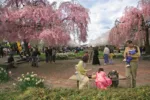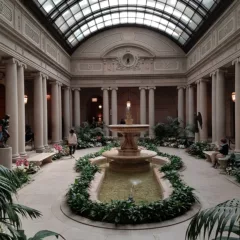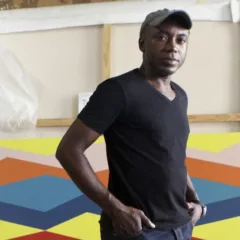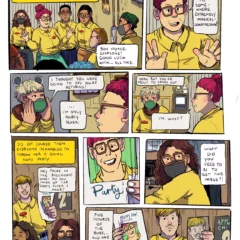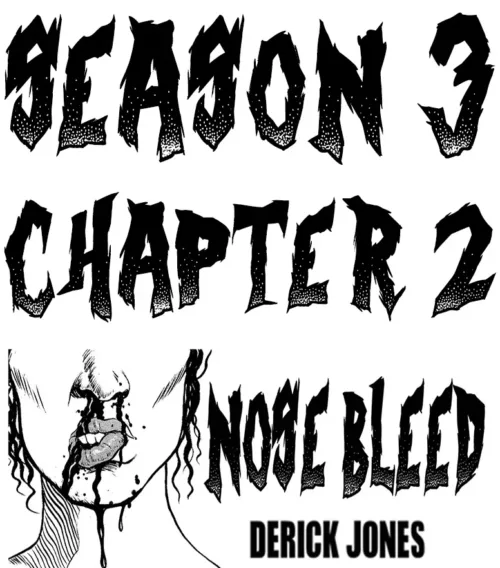Episode 273 – In this edition of Artblog’s Midweek news Roberta and I discuss Pepón Osorio at Jefferson Hospital, Philadelphia Folklore Society working with the Free Library of Philadelphia, Refik Anadol’s AI art Casa Batlló. I share my 3 picks from ArtblogConnect.org this week and we discuss Miranda July’s latest book, All Fours as well as George Saunders’s book Lincoln in the Bardo. Thanks for listening ~ Ryan
Audio Player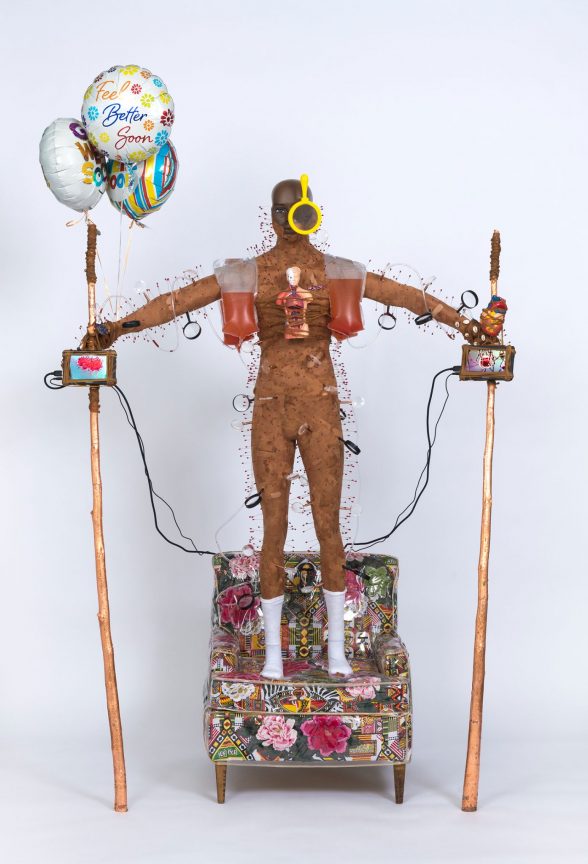
Wood, mannequin, two channel video, pins, magnifying glasses, anatomical model, bandages, rubber, medical equipment.
Click to expand the podcast transcript
Roberta: Hi everyone. It’s Roberta.
Ryan: And this is Ryan, and this is the Midweek News
Roberta: On Artblog Radio. Let’s go to the news. Shall we? Okay, so I have three things that I’m excited about this week, and I believe I haven’t told you about them before. So, Ryan, you’ll correct me if I have please. The first is Pepón Osorio, local artist, MacArthur Genius, incredible, incredible artist of community practice. Just one of his big pieces was called My Beating Heart, and that is really him, his heart just beats for his community, Puerto Rican American. And anyway, he has a new show coming up at, of all places, Thomas Jefferson University. Now you ask why, and this is because the show is called Convalescence and it’s about the healthcare system and people interacting with the healthcare system. And Pepón has always dealt with systems. He dealt with the juvenile justice system (in Trials and Turbulence) at the ICA with a very sprawling installation, and he uses found materials, in other words actual materials from the system, and then (creates) videos of people who have been affected by the system. So juveniles, he’s done. The first piece I remember seeing of his was No Crying In The Barbershop. It was about machismo and how (Latino boys), you know, have to suck it up; the (boys and) men can’t cry in the barbershop. It was amazing. It was actually a barbershop in a gallery.
More recently he did Reform, which is about a school closing in the Latino community in North Philadelphia, that was devastating to the students and the families. And that was amazing. That was at Temple University, that piece, because Pepón teaches at Tyler School of Art and Architecture.
Anyway, Convalescence is, I guess, kickstarted by Pepón’s own experience with cancer treatment. He had cancer, he went through the treatment system. And so he is all about that now and he is revealing problems with the system as it exists, and good things in the system as it exists. And so thus Thomas Jefferson University is partnering with Pepón and I forget where the funding comes from (Pew Center for Arts and Heritage, William Penn Foundation, Wagner Foundation), but it sounds like a marvelous piece of local, really relevant art and there are going to be public programs in the fall. This opens August 30th, or I’m sorry, September 3rd to November 1st are the dates, and between those months there will be a talk with Pepón and there’s other kind of things that are going to happen, workshops and whatnot. So that’s number one.
And I’m sorry I went way overboard on that, but we’re, if you look on Artblog and Google up Pepón Osorio on Artblog, you’ll find that we’ve written about him a million times. We are major fans of Pepón. Love you Pepón.
Secondly, and I’m excited about this too. The Philadelphia Folklore Society is partnering with the Free Library to do 25 art workshops in September at the various branches. And this sounds really excellent to me. I don’t know that they’ve done exactly such a partnership before, with the library, the Folklore Society has undergone some leadership changes. During the pandemic, they lost their founder, Deborah Kodish, who was a long time executive director and leader, and they have brought in new people since then. But the organization, like all the arts organizations has had difficulties fundraising and just managing after the pandemic. So this sounded like a really good thing to partner up with the Free Library and do things in the Free Library branches. So bravo. We’ll put some links into all these things in the transcript.
Finally, I have some AI news, and maybe it’s old news to some of you, but to me it was new. Refik Anadol, who was the darling of the AI art producers was at MoMA, I guess it was with a big installation of his art that was based on MoMA’s Art collection has a new piece called Gaudi Dreams. He worked with a place, a group called Casa Batlló, B-A-T-L-L-O, with an X. You know, and. What do you call that? The sign on top of the O, whatever it is. Accent mark on the O. There’s a beautiful YouTube video of this where Rafik is talking about Gaudi dreams. This is the third project he’s done for this organization, which is apparently conserving the Gaudi architectural masterpieces in Barcelona.
So I thought that was good. And Refik talks a little bit about the future of AI and art and how excited he is that not only is he doing it, but he’s welcoming a future generation and happy to see that this particular place is into it. You know, not all places are into it. So it was all very positive AI talk, AI and arts, and that’s it for me.
Those are my three things. What do you have for us today?
Ryan: So ArtblogConnect continues to be bustling. A lot of things getting posted, a lot of things that looked really interesting. Something citywide that I wanted to, to mention that I thought was really interesting and I’m hopeful about is Mural Arts has a piece that they’re building with Bartram’s Garden and a art architectural firm. They are building a float lab. It’s a permanent floating art installation along on the Schuylkill River.
Roberta: Yeah, we wrote about that when they first introduced that a while ago. Right. And I thought, that is really, really cool.
Ryan: And I think it’s coming to fruition. They’re starting construction. So the construction’s starting. So they put together the funds and the space and so yeah. So obviously that’s been in the works for a while and that won’t be completed in until 2026.
Roberta: I hope they get that spill, the pollution spill, the contamination that. Prohibits people from going on the trails at Bartram’s now because there’s Yeah. Some bad stuff there. I hope they get that cleaned up.
Ryan: Yeah, there’s a lot of things going on in that area that I think could be really positive in the next couple years. Both this, this installation piece that’ll be permanent and I, I know there’s a lot of work they have to do along the river, but there’s also the bridge that they’re trying to connect that will hopefully be done whenever it’s completed.
Roberta: Across the Schuylkill from Bartram’s to the other side.
Ryan: Right. That’s that connecting bridge,
Ryan: So it’ll keep the path going.
Roberta: Oh, that’s great.
Ryan: Yeah, I think so too. So that’s been in the works for a couple of years, so I’d love to see that happen. Yeah. Things that come up on Connect this week.
One is Solar Myth is hosting Isaiah Collier and the Chosen Few, if you’re interested in some live music that’s on August 23rd. Also, for music up in my neighborhood is the Germantown Sound Sessions. That’ll be at Our House Culture Center at 6380 Germantown Avenue. That is also this Friday. You can find those events on Art Blog Connect, and then there’s quite a few different marketplaces happening.
And then there’s one on Eakins Oval, which will be interesting as well on Saturday. Hmm. Then don’t forget that something that Roberta had mentioned before, which was the no arena drag show that’s coming up this Saturday as well. That’s from five to eight. That’s a folk art, cultural treasures charter school.
Say that three times fast. That’s from five to eight as well. So that’s coming up. So again, a lot of, lot of great stuff here at the end of August, which is exciting,
Roberta: isn’t it? It’s really great.
Ryan:. Yeah. School, I guess is getting into session if, if you’re getting into that. So get excited Summer’s about wrapping up.
Roberta: Well, you know, speaking of school, there’s been a lot written about the University of the arts, the arts students, and where they’re now going. Mm-Hmm. There’s some 300 that are going to be at Tyler this fall. Mm-Hmm. That’s pretty good. Or, or temple in general? I think some of them, yeah. You know, the media, the filmmakers are going to be in a different depart, different school than Tyler.
Tyler doesn’t really do filmmaking. I think there’s media arts department at Temple, but, Moore College is absorbing, I guess is the right word. Mm-Hmm. 112 UR students. Great. And that pretty much pushed their, their population to over 500 students, which is a new benchmark for them. Great. And they’re like, wow, that’s great.
They’re like gearing up for the, you know, the campus and to, you know, accommodate all these new students. So it’s really wonderful what’s happening with. You know, it’s, it’s not without rocks. There’s some rockiness going on. You know, like the financial aid packages are not exactly the same and yada, yada, yada.
But I think the institutions like Moore and temple and the others, I can’t remember who else, but there’s been a bunch other. Drexel and Arcadia took a bunch. I think Drexel took 90 and Arcadia has like 25. I mean, that’s, those are serious commitments to those students, which is really wonderful. And they should be applauded.
And you know we still don’t know the cause of all this, but it’s just, we’ll have to wait until we know. There’s, we can speculate all we want.
Ryan: There’s been some interesting articles on that topic. I’ll bet there have. So, but you know, it all comes down to money and how you manage it. I think so. And obviously it was mismanaged and done poorly.
Roberta: Yes, absolutely.
Ryan: I. Oh, and I usually, and I forgot to mention, I usually give out a theater shout out. And so coming up this weekend, it’s just a three day show. It’s theater in the X, so that’s Malcolm X Park in West Philly is one monkey. Don’t stop, no show.
And that, take a look at that. There’s, there’s just a few days left of that, that that’s a free show. But you have the, I believe you have the reserve tickets for that.
Roberta: And it’s outside in the park.
Ryan: It’s in the park and I think the weather will be obliging. So yeah,
Roberta: I was going to say, this is the week to see it.
Ryan: This is the week to see it. So looking forward to that.
Roberta: It’s nice to have the change in the weather and it’s good to have. Things to work on. Projects to work on. I’m very excited about our art market, the art blog art market that we’re doing at Moore College in the fall, and excited to work with two New Penn students.
We’re getting two, university of Pennsylvania non-profit leadership program, graduate students, and we want to welcome them. One of them is Anjali Miller, and the other is Yan Chi. It’s going to be great working with these young students. They’re very excited about our art market, so I can’t wait to put them to work at that.
And then I went to the Art Museum Friday night. Libby and I went to the Art Museum to see Megan Bridge, who’s a dancer with her son Tristan, who’s a cellist do the Bach Cello Suite number two project, which was pretty amazing. You know, we sat on the Great Hall steps and the performance was only 25 minutes long, roughly. But it was compelling that Bach music, you cannot get around the majesty of it. It’s just for Western music. It is, I think, a pinnacle, you could argue anyway. And then the dance was really beautiful. She did a very beautiful. Interpretation of the B or response to the B. So that, that’s what I did this weekend.
What did you do this weekend?
Ryan: This weekend was birthday weekend, so we did lake time. My daughter loves swimming, so we spend a lot time in the lake. Mm-Hmm. And kayaking. And there we did some mountain biking, so a lot of up north activities.
Roberta: When you speak of the lake, are you talking Michigan or are you talking some other lake?
Ryan: Yeah, lake Michigan.
Roberta: So the lake.
Ryan: One of the big lakes, it’s always, it’s nice because you get the a lot of the benefits of an ocean, at least the views because you can’t see the other side. It feels large and but it’s also Lake Michigan does feel rather clean, especially in the Michigan side.
It feels really nice and clean and I haven’t spent as much time on the Wisconsin side, so I can’t speak to that, but it’s. You can see your feet for a, a long way. It stays nice and shallow a a long way. And most of the beaches are not too rocky, so you get a lot of nice sand. So we were, we were near Saugatuck, which is a nice little touristy town. Some nice beaches.
Roberta: Very cool. Yeah. Yeah. The Wisconsin side is rocky. I, I think we’ve talked about this before. You guys got on Michigan side, got the good side Michigan, and we got the, this may be the fault of the glacier because Wisconsin is full of kettles and marines, which are the depressions and then the buildups of rocks when the glacier melted and all that stuff.
There’s a state park called Kettle Marines, State Park, or Forest. I forget. But Wisconsin got, you know, a lot of glacial action and I think that probably accounts for the beaches being quite rocky on the, the Wisconsin side of Michigan. Yeah, I don’t know. That’s a theory I just made up, so I’ll have to science check that one. Sounds good. But but you’re back now, right? Back in, you’re not Michigan anymore
Ryan: My travels are done for the summer. I’m long terming it here back in Philly again. It’s nice to be back when the weather is, is a little bit cooler. That’s nice. Oh, well, today, yes, hopefully, hopefully this week looks nice.So, I mean hopefully the weather stays like today.
Roberta: Last week was kind of bad, but this week looks like it’s going to be in the low seventies, which is delightful. Yeah. So we’ll take, we’ll take it.
Ryan: I love fall. I’m ready.
Roberta: Yeah, me too. Me too.
Ryan: But I was just reading, Miranda July. I was just reading All Fours. Have you read any Miranda July before?
Roberta: I haven’t. Do you recommend?
Ryan: It’s interesting, the premise it is hard to even express what the premise is. I think it’s hard. I think it’s more fun just to read it, not knowing what is, what’s going to happen. Mm-Hmm. So then it just like, oh, okay, we’re going to do this.
So I feel like if you look at what the book is about, it kind of. Eliminate some of the, the potential joys that are available to it. Hmm. And I, I think only after reading what I say, that there is joy to the, to the book. Hmm. I’m not sure reading, while reading it, what I, what I use that adjective to describe it in any way.
Roberta: You were not experiencing joy.
Ryan: Not while reading it, but I think afterwards and on reflection it, I, I found it more enjoyable. The reading itself was interesting. So then I, so then someone else had another Miranda July, so that was my first real experience reading, reading her work. And so I went back and, and read another one of her, her works.
And I don’t think I’ve experienced a protagonist quite like the way Miranda July puts, makes her protagonists. Hmm. I found them unique and at first, I. A little bit unapproachable, a little bit difficult to connect with, and, but by the end you are rooting for them, which is, which is nice. I feel like that doesn’t happen quite as much as I would like.
Roberta: No, she, that sounds like it was subtle, the subtle subtlety of having a character change so much. If you’re riding cowboys and Indians, you’re going to have good guys and bad guys and nobody’s going to change. Not so much. And like cops. In our detective fiction, there’s always bad guys and the detectives are the good guys.
But if you’re writing something more nuanced, I think it’s good to have an accomplishment, to get a character to change. I.
Ryan: Yeah. And I think she kind of specializes in this unreliable narrator voice where you can’t quite trust anything that’s being written. This is why I think the joy isn’t necessarily accessible until you are reflecting on the entirety of the work as opposed to as you’re going through it, you can’t quite see, ’cause you can’t quite trust what’s happening.
But then once you get the full picture, you can reflect on it. Yes. But while you’re going through it. It’s, it’s interesting because she won’t necessarily tell you who’s saying what when, and, and there’s a lot of leeway and, and with, with time and what’s happening or didn’t happen. Like, is, is this an activity of the mind of the, the, the narrator or the protagonist, or is it actually happening?
And you’re not always quite sure. It doesn’t leave you dangling. Like you’re, you’re wondering what happened necessarily by the end, but you’re certainly, while you’re in it not feeling solidly foundation of Yeah. Of what’s happening. The narrative is not quite true or real. It’s a perspective.
Roberta: If I can just put another book in play.
One that I did not have joy reading, although I did have moments of laughter. Until after the book was done and then I reflected back on it. And that’s Lincoln in the Bardo. Have you read that? The George Saunders book? It’s a weird book. It’s I can’t even describe it, but it has a way of writing that is.
Sort of a mockery of literary academic writing with i, I, and, you know, all those kind of things that you find in academic writing. But there are all quotes from people who are saying things, and there’s a lot of characters and half of them are alive, and only a few of them are no, most of them are dead.
And then there’s Lincoln.
Ryan: Interesting.
Roberta: It’s a really, I loved it. Not everybody loved it. It was my piece of cake, but it was hard getting through, really hard getting through until the end. And then I got the big picture I understood, and it was marvelous.
Ryan: Yeah. I’ve read a few like short story collections of George Saunders and other things of that. But I haven’t read this piece. And it’s interesting you mentioned him because he’s one of the, did, I can’t remember if he wrote the foreword or if he’s just on the. On the book jacket of, of the all fours talking about Oh, interesting. Interesting. About her. Yeah. So that’s an interesting connection.
Roberta: Yeah. Kindred spirits. Yeah. He’s prolific.
Ryan: Yeah. Kindred spirits. I think so too. I think they have a similar wit.
Roberta: All right. Well we should probably wrap it up here.
Ryan: Yeah.
Roberta: Great. So that’s it for me at the moment and I’m going to say thanks for listening, everybody. We’ll be back next week. It’s Roberta,
Ryan: And this is Ryan. And this has been Artblog Radio’s Midweek News. See you again.
Roberta: Bye.
Ryan: Bye-Bye.
Meet Our Hosts




